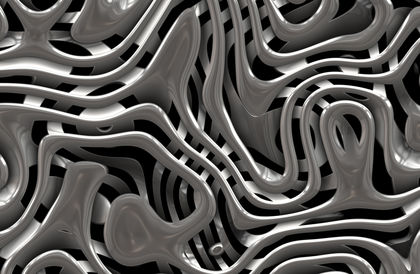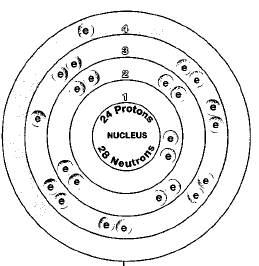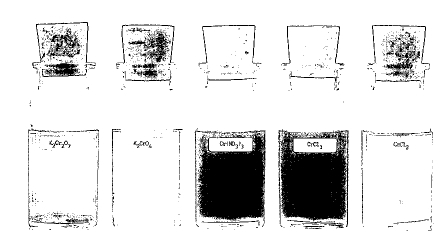CHROMIUM


Overview
Chromium is found in the center of the periodic table, a chart that shows how chemical elements are related to each other. Elements in Groups 3 through 12 are known as the transition metals. These elements all have similar physical and chemical properties. They have a bright, shiny surface and high melting points.
Chromium was discovered in 1797 by French chemist Louis-Nicolas Vauquelin (1763-1829). The name comes from the Greek word chroma, meaning "color," because chromium compounds are many different colors.
About three-quarters of chromium produced today is used in alloys, including stainless steel. An alloy is made by melting and mixing two or more metals. The mixture has different properties than the individual metals. Chromium is also used to cover the surface of other metals. This technique protects the base metal and gives the surface a bright, shiny appearance at a low cost.
SYMBOL
Cr
ATOMIC NUMBER
24
ATOMIC MASS
51.996
FAMILY
Group 6 (VIB)
Transition metal
PRONUNCIATION
CRO-mee-um
Discovery and naming
Chromium was discovered in a mineral known as Siberian red lead. The mineral was first described in 1766 by German mineralogist Johann Gottlob Lehmann (1719-67). Scientists were puzzled about what elements this new mineral contained. It had a form and a color not seen in other minerals. In some cases, it was found, as some said, "attached like little rubies to quartz."
Studies of Siberian red lead were difficult, however. It was mined at only one location in Germany and miners found it difficult to remove. Scientists had only small amounts of the mineral to study. They guessed that it contained lead as well as arsenic, molybdenum, or some other metal.
In 1797, Vauquelin began his own studies of Siberian red lead. He was convinced that the mineral contained a new element. None of the elements then known could account for his results. He reported "a new metal, possessing properties entirely unlike those of any other metal."
A year later, Vauquelin was able to isolate a small sample of the metal
itself. He heated charcoal (nearly pure
carbon
) with a compound of chromium, chromium trioxide (Cr
2
O
3
). When the reaction was complete, he found tiny metallic needles of
chromium metal:
The name chromium was suggested by two French chemists, Antoine Francois de Fourcroy (1755-1809) and René-Just Haüy (1743-1822), because chromium forms so many different colored compounds. The colors range from purple and black to green, orange, and yellow.
Physical properties
Chromium is a hard, steel-gray, shiny, metal that breaks easily. It has a melting point of 1,900°C (3,450°F) and a boiling point of 2,642°C (4,788°F). The density is 7.1 grams per cubic centimeter. One important property is that chromium can be polished to a high shine.
Chemical properties
Chromium is a fairly active metal. It does not react with water, but reacts with most acids. It combines with oxygen at room temperature to form chromium oxide (Cr 2 O 3 ). Chromium oxide forms a thin layer on the surface of the metal, protecting it from further corrosion (rusting).
Occurrence in nature
The abundance of chromium in the Earth's crust is about 100 to 300 parts per million. It ranks about number 20 among the chemical elements in terms of their abundance in the earth.
Chromium does not occur as a free element. Today, nearly all chromium is produced from chromite, or chrome iron ore (FeCr 2 O 4 ).
The leading producer of chromite ore is South Africa. Other important producers are Kazakhstan, Turkey, India, Finland, Albania, and Brazil. There are no chromite mines in the United States.
Isotopes
There are four naturally occurring isotopes of chromium: chromium-50, chromium-52, chromium-53, and chromium-54. Isotopes are two or more forms of an element. Isotopes differ from each other according to their mass number. The number written to the right of the element's name is the mass number. The mass number represents the number of protons plus neutrons in the nucleus of an atom of the element. The number of protons determines the element, but the number of neutrons in the atom of any one element can vary. Each variation is an isotope.
Seven radioactive isotopes of chromium are known also. A radioactive isotope is one that breaks apart and gives off some form of radiation. Radioactive isotopes are produced when very small particles are fired at atoms. These particles stick in the atoms and make them radioactive.
Chromium compounds' colors range from purple and black to green, orange, and yellow.
One radioactive isotope of chromium is used in medical research, chromium-51. This isotope is used as a tracer in studies on blood. A tracer is a radioactive isotope whose presence in a system can easily be detected. The isotope is injected into the system at some point. Inside the system, the isotope gives off radiation. That radiation can be followed by means of detectors placed around the system.
A common use of chromium-51 is in studies of red blood cells. The isotope can be used to find out how many blood cells are present in a person's body. It can be used to measure how long the blood cells survive in the body. The isotope can also be used to study the flow of blood into and out of a fetus (an unborn child).
Extraction
The methods for producing chromium are similar to those used for other
metals. One method is to heat chromium oxide (Cr
2
O
3
) with charcoal or
aluminum.
The charcoal (nearly pure carbon) or aluminum takes oxygen from the
chromium oxide, leaving pure chromium metal. This method is similar to the
one used by Vauquelin:
Chromium can also be obtained by passing an electric current through its
compounds:
Sometimes chromite is converted directly to an alloy known as
ferrochromium (or ferrochrome):
Ferrochromium is an important chromium alloy. It is used to add chromium to steel. When steel is first made, it is a very hot, liquid material. To make chromium steel, ferrochromium is added to the hot liquid steel. There, the chromium dissolves into the hot steel. When the molten steel hardens, the chromium is trapped inside. It is now chromium steel.
The radioactive isotope chromium-51 is used to study the flow of blood into and out of a fetus (an unborn child).
Uses
About 87 percent of chromium used in the United States goes into alloys. The addition of chromium makes the final product harder and more resistant to corrosion. About 70 percent of all chromium is used in the production of stainless steel. The applications of stainless steel are almost endless. They include automobile and truck bodies, plating for boats and ships, construction parts for buildings and bridges, parts for chemical and petroleum equipment, electric cables, machine parts, eating and cooking utensils, and reinforcing materials in tires and other materials.
Two other major uses of chromium are electroplating and the manufacture of
refractory bricks. Electroplating is the process by which an electric
current is passed through a water solution of a metallic compound. The
current causes the material to break down into two parts, as the following
reaction shows:
The free chromium produced in this reaction is laid down in a thin layer on the surface of another metal, such as steel. The chromium protects the steel from corrosion and gives it a bright, shiny surface. Many kitchen appliances are "chromeplated" this way.
Some chromium is also used to make refractory bricks. A refractory material can withstand very high temperatures by reflecting heat. Refractory materials are used to line high-temperature ovens.
Compounds
Chromium compounds have many different uses. Some include:
chromic fluoride (CrF 3 ): printing, dyeing, and mothproofing woolen cloth
chromic oxide (Cr 2 O 3 ): a green pigment (coloring agent) in paint, asphalt roofing, and ceramic materials; refractory bricks; abrasive
chromic sulfate (Cr 2 (SO 4 ) 3 ): a green pigment in paint, ceramics, glazes, varnishes, and inks; chrome plating
chromium boride (CrB): refractory; high-temperature electrical conductor
chromium dioxide (CrO 2 ): covering for magnetic tapes ("chromium" tapes)
chromium hexacarbonyl (Cr(CO) 6 ): catalyst; gasoline additive
Health effects
Chromium is an element with two faces, as far as health effects are concerned. Small amounts of chromium are essential for the

The addition of chromium makes the final product harder and more resistant to corrosion.
In larger amounts, chromium is harmful. Some compounds are especially dangerous, causing a rash or sores if spilled on the skin. They can also cause sores in the mouth and throat if inhaled. If swallowed, some chromium compounds can seriously damage the throat, stomach, intestines, kidneys, and circulatory (blood) system. Scientists believe exposure to some chromium compounds on a long-term basis causes cancer. As a result, the U.S. Environmental Protection Agency (EPA) has established rules about the amount of chromium to which workers can be exposed.
OSHA has a comprehensive regulation on Chromium VI to protect workers. They have limits of exposure for Chromium III.